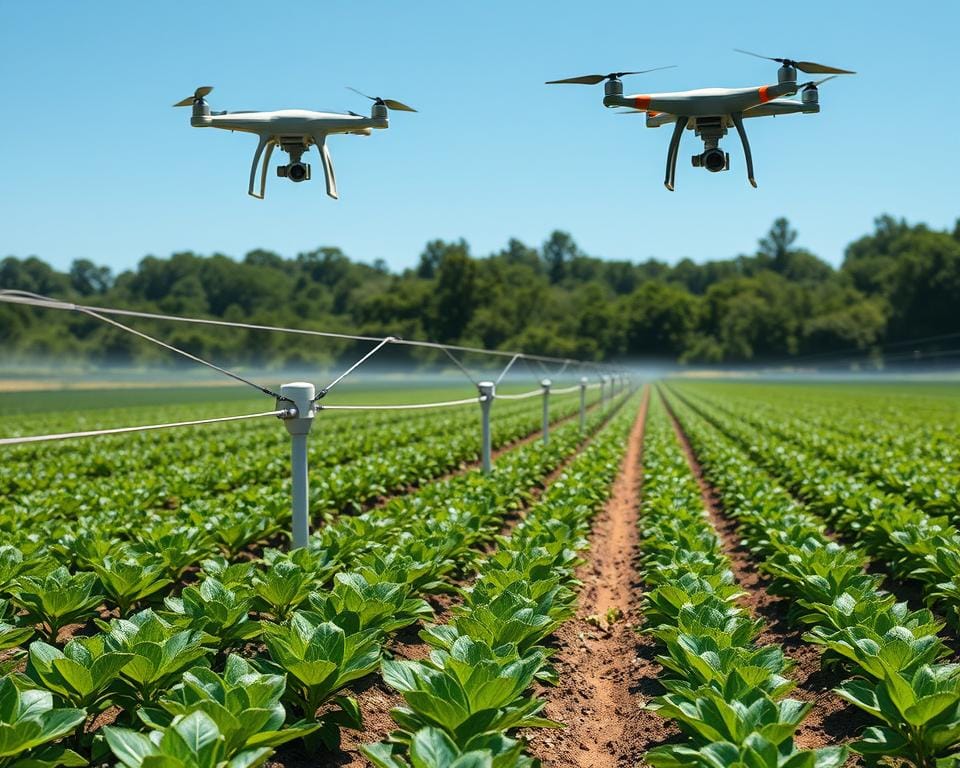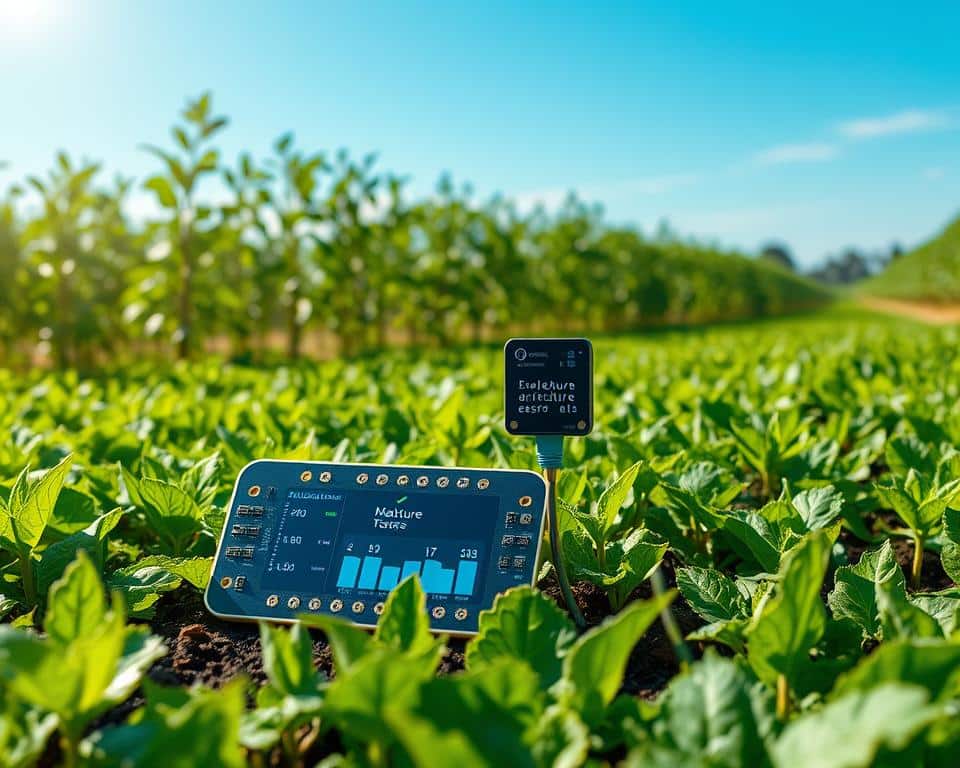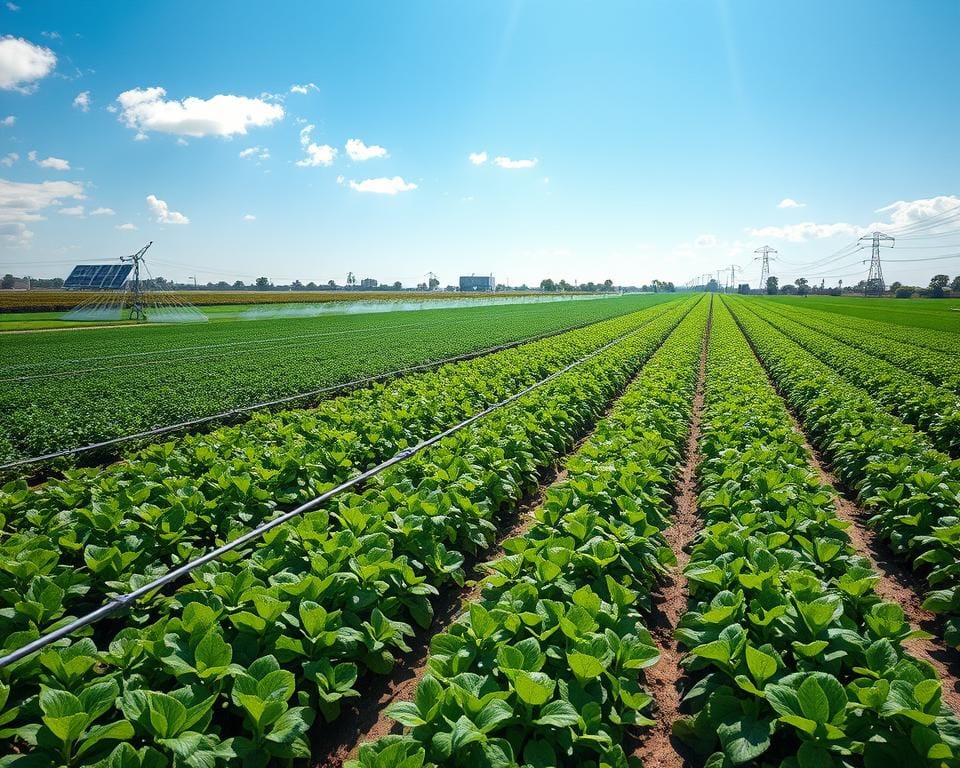Discover the future of water management in farming through smart irrigation. These smart solutions are a must for sustainable farming. Traditional watering uses about 70% of the world’s fresh water. So, it’s crucial we adopt efficient tools to save this vital resource.
Smart irrigation has changed the game by solving overwatering and underwatering issues seen in old systems. These smart technologies make sure water goes exactly where and when it’s needed. They use data to handle the tricky part of farming—watering—with ease and efficiency.
With the world population growing and climate change affecting water, farming needs to use water better. Implementing smart watering can save costs and boost crop growth. Smart systems can cut water misuse by up to 60%, leading to greater profits and investment returns.
These smart systems also protect our planet by reducing water waste and pollution. They’re easy to maintain and use real-time data from advanced analytics. By using state-of-the-art technology like IoT, AI, and machine learning, farmers can find the best times to water their crops. This enhances both productivity and sustainability.
Switching to smart irrigation fits with eco-friendly farming and prepares us for a future with less fresh water. Investing in these systems is smart for your wallet and the planet. It’s a step towards a greener, more water-conscious farming future.
Introduction to Smart Irrigation Systems
Smart irrigation systems change how we water crops by using new tech. They use sensors and weather data to make sure water goes exactly where and when it’s needed. Since farming uses about 70% of the world’s fresh water, saving water is critical.

Definition and Overview
Smart irrigation controls water use smartly and without much human help. It uses different sensors to collect data on moisture, wind, and evaporation. This helps decide the best watering plan for each crop and area.
By using smart tech, we can save 20-40% more water than old ways do. This big drop in water use helps our planet a lot. Also, these systems can work on their own, which cuts down on hard work and lets farmers control things from afar.
The Growing Need for Water Conservation
Water is getting scarce, making it a big problem worldwide. Agriculture has to use smart watering to grow food without wasting water. Smart systems can cut water use by 30-50%, which really helps save this precious resource.
These smart systems are also good for the planet and can lower the cost of moving water around. By using IoT tech, farms of any size can find a system that suits them, helping all kinds of crops.
To wrap it up, adding smart irrigation is a must in today’s farming world. These systems improve how we manage water, playing a key part in saving water. They make farming more sustainable and efficient for the future.
Components of Smart Irrigation Systems
The heart of smart irrigation is found in its parts. This includes sensors and software that focus on data. Controllers act as the brain, making watering decisions based on sensor info. These sensors check things like soil wetness and temperature. They’re key for knowing how much water is needed.
Adding weather and soil moisture data, along with flow meters, ensures proper watering. Real-time analytics help the system quickly adjust to weather changes. This protects plants and saves water. AI and ML help in predicting needs, helping farmers use resources wisely.
Sensors and Controllers
The main parts of a smart irrigation setup are the sensors and irrigation controllers. They work together to water plants just right. Smart sensors track soil conditions and climate. While old valves open or close with electricity, smart valves with sensors adjust watering on the fly.

Weather-Based Monitoring
Keeping an eye on the weather is key for smart watering systems. They use weather data to adjust how much water plants get. Smart controllers cut down on water use when it rains. Or they use more water when it’s hot and dry. This method is great for saving water and for farming with precision.
Soil Moisture Sensors
Checking soil moisture is critical for good irrigation. Soil sensors measure how much water is in the ground. This info stops too much or too little watering. It means plants stay healthy, which is especially good in dry places like Texas. It helps save water.
Advanced Analytics and Real-Time Data
Using data smartly is at the core of modern farming. Smart irrigation systems change their watering based on new sensor data. This lets farmers make quick, smart choices. Data helps find ways to use water better, saving money and growing more crops. Predictive analytics make these choices even smarter, tailoring water use to each field’s needs.
- Texas: Smart sprinkler systems conserve scarce water resources.
- WiFi Controllers: Adjust watering schedules using weather forecasts.
- Smart Valves: Offer real-time feedback for even water distribution.
- Sprinkler Heads: Customize watering based on needs.
- Backflow Preventers: Prevent contaminated water from re-entering clean supplies.
- Zoning: Customizes watering for different zones to reduce waste.
- Soil Moisture Sensors: Optimize water levels for plants.
- Weather Sensors: Adjust watering based on real-time data.
- Drip Line Systems: Ensure efficient water use.
- Upgrade: Conserve water by adjusting schedules.
Benefits of Smart Irrigation Systems for Farmers
Smart irrigation systems bring many benefits, improving modern farming. They focus on sustainability and innovation in agriculture. Farmers use these systems to make their work more effective and environmentally friendly.
Water and Cost Savings
These systems are key in saving water and money. They use IoT technology to cut down on energy use in farming. They adjust how much water to use by looking at soil and weather data.
This means less water waste and lower bills. It makes farming more efficient by reducing costs.
Improvement in Crop Yields
Eco-friendly technology boosts crop yields. It ensures plants get just enough water at the right times. This improves how water is used.
Smart systems provide data on soil and weather, informing farming decisions. This results in better crops and more output.
Environmental Protection
Smart irrigation helps the environment. It lessens water runoff and the harm of fertilizers and pesticides. These systems reduce the environmental impact, supporting sustainable farming.
This helps save natural resources for the future.
Increased Efficiency and ROI
Smart systems increase water use efficiency with farm software. This brings high efficiency and return on investment (ROI) for farmers.
Farmers often see ROI in one to three years, thanks to water and labor savings. Government incentives support using these technologies. These systems also provide data, boosting crop performance and profits.
Types of Smart Irrigation Technologies
New technology in agricultural IoT devices has introduced various smart watering methods. These methods meet different farming needs and environments. One major breakthrough is weather-based irrigation systems. They change watering schedules using real-time weather data. This prevents wasting water when it’s raining. It also supports using water wisely and helps the environment.
Soil moisture-based irrigation uses sensors to track soil moisture in real time. This means no more guessing on how much water plants need. It stops plants from getting too much or too little water. As a result, plants grow healthier, and water use is reduced. In fact, using AI in these systems can cut water use by up to 25%.
Smart sprinkler systems are another popular choice. They let farmers change watering times from anywhere using Wi-Fi. Farmers use apps or web interfaces to do this. Thanks to smart algorithms, these systems reduce wasted water. They also improve crop yields by 20 to 30%.
Drip irrigation systems with smart controls are all about saving water. They use sensors and analytics to adjust to the environment perfectly. AI-driven systems can even spot diseases, pests, or nutrient problems early on in plants.
Choosing these new irrigation technologies brings many benefits. They use water more efficiently and reduce costs. They can even make properties more valuable. Features like remote management, customizable watering areas, and helpful water usage data make farming easier. They create a farming system that’s good for the wallet and the planet.
| Technology | Key Features | Benefits |
|---|---|---|
| Weather-Based Irrigation Systems | Adjusts watering schedules based on real-time weather data | Prevents water wastage, promotes sustainability |
| Soil Moisture-Based Irrigation | Real-time soil hydration levels, AI integration | Optimizes water usage, healthier plant growth |
| Smart Sprinkler Systems | Wi-Fi controlled, remote monitoring | Minimizes water wastage, increased convenience |
| Drip Irrigation Systems | Intelligent controls, advanced analytics | Efficient water conservation, adaptive responses |
Conclusion
Exploring smart irrigation technologies shows us a world full of possibilities for saving water and making irrigation smarter. Looking into the future, these advanced systems are key to better farming. They use live data, check the weather, and track soil moisture to make watering more exact. This helps farmers and protects the environment.
Smart farm technologies are growing fast, expecting a 12.7% increase in money made from 2024 to 2030. These systems make sure we use every bit of water carefully. They stop too much watering and keep plants healthy. Plus, they can lower water bills and might get you rebates, making them a smart choice for saving money.
But the benefits aren’t just about money. Using water wisely is important, especially in places with little water or strict water rules. Smart irrigation helps save valuable water, reduces waste, and keeps plants and grass healthy. This makes the air cleaner and our environment better. By using these technologies, we’re making farming ready for the future, ensuring it’s tough and eco-friendly.

